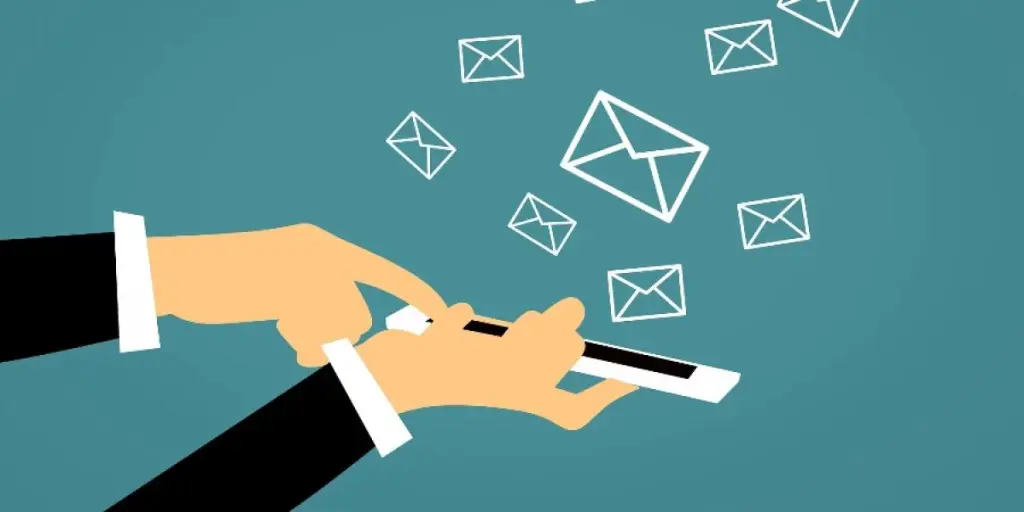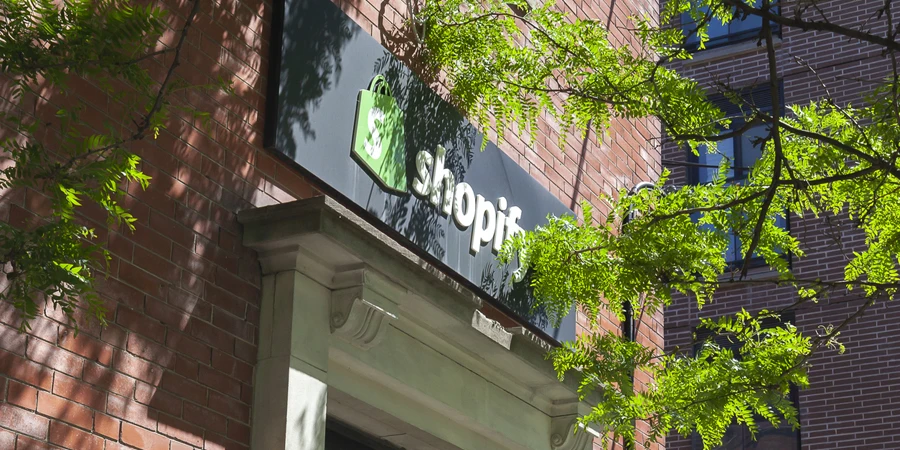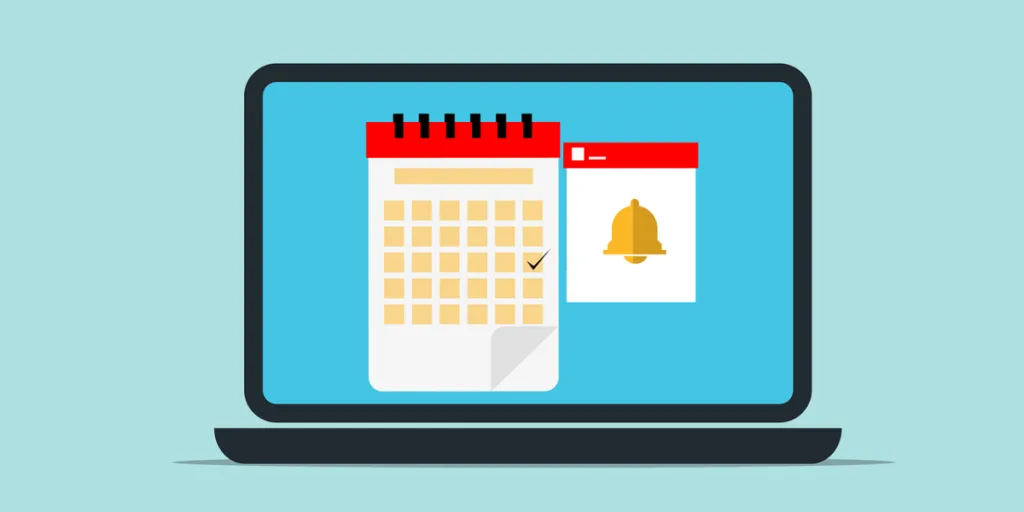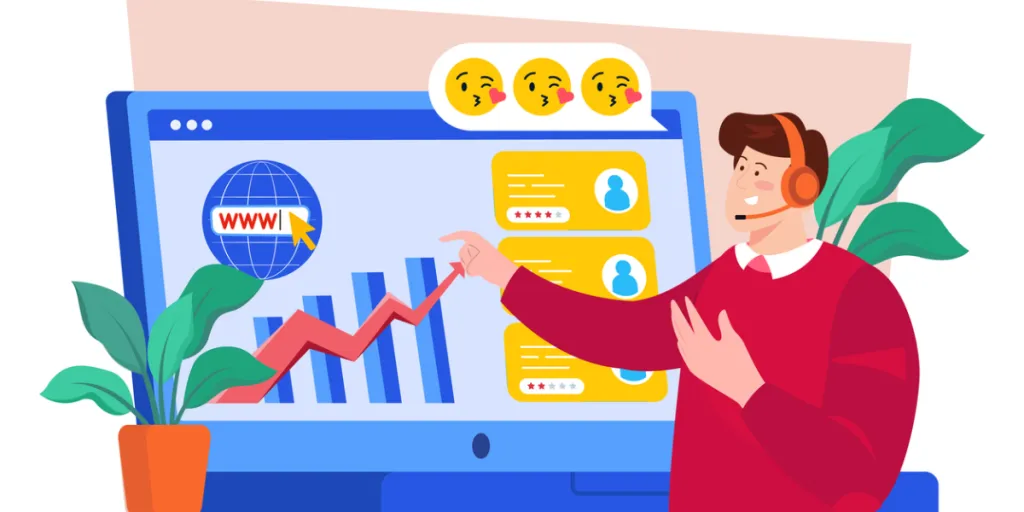The biggest myth about email marketing funnels is that there’s a universal approach to getting the best results. Many people believe that there’s a standardized structure that fits all audiences across businesses in all industries.
The truth is, there’s no standardized structure that fits every need.
A customer’s journey may have similar stages but is unique for every business. An effective email marketing funnel should be tailored to the specific behavior of your target audience.
We’ll guide you on how to create an email marketing funnel to get the best results from your email funnel strategy.
Table of Contents
What is an email marketing funnel?
How to build an email marketing funnel
Email marketing funnel: Summary
What is an email marketing funnel?
An email marketing funnel is a series of emails strategically designed to nurture a lead and drive conversions. It’s also useful for turning existing customers into loyal customers.
Effective email marketing funnels are designed keeping the target audience in mind. You need to create different emails for customers at different stages of their journey.
The main stages of a buyer’s journey that an email marketing funnel addresses include:
- Awareness
- Consideration
- Conversion
- Loyalty
- Retention
Each company should design its email funnel based on its priorities and needs. Here’s an example of an email marketing funnel to get you started.
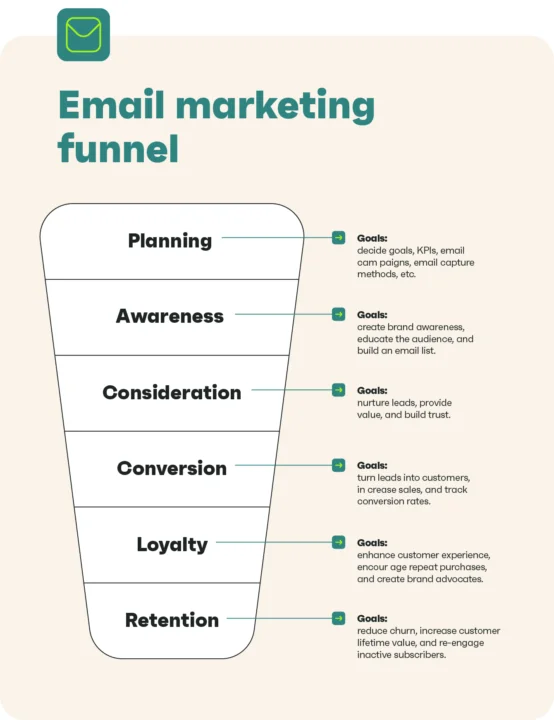
We’ve added a ‘planning’ stage on top. It’s not part of the standard email marketing funnel but it’s critical nonetheless.
There are two benefits that an email marketing funnel will have:
- It gives you a better understanding of your customers’ needs. It lets you know the motivations guiding their decisions at different stages of the email sales funnel.
- It makes personalization easier for you. Understanding the interests, preferences, and engagement levels of your subscribers at different buying stages helps you tailor your educational and promotional content accordingly.
You can modify the email sales funnel on the go. It’s not cast in stone, you’re free to adjust your email marketing funnel depending on how your audience interacts with your brand.
How to build an email marketing funnel
Building an email marketing funnel involves nurturing subscribers from the initial contact to conversion using these steps:
- Plan your email funnel
- Convert visitors into subscribers
- Nurture your list
- Convert subscribers into customers
- Build customer loyalty
- Retain and re-engage subscribers
1. Plan your email funnel
Stage: Planning
Here are some things you need to take care of before you build your funnel:
- Conduct customer research: Develop an in-depth understanding of your customers’ needs and pain points. Keep track of their changing preferences, which will help you tailor your messages and offers.
- Create a customer journey map: This is a visual representation of the steps a customer takes from first interaction with your brand to conversion. It helps you understand the customers’ perspectives and needs.
- Design opt-in forms: Create engaging popups to capture leads and build your email list. Opt-in forms provide your prospects’ consent to receive communication from you. The customer data you collect will also help with segmentation.
- Create landing pages: You’ll need landing pages to provide website visitors with a lead magnet to encourage signups. Links that your recipients click on your emails should drive them to dedicated landing pages where they can engage more with your brand.
- Define your strategy goals: Ensure your email marketing strategy aligns with your business goals. If your goal is to build loyalty, your email marketing funnel should build meaningful connections with customers.
You also need an email marketing app with a free plan.
We recommend Omnisend—an email app you can use to build the entire email funnel. You can use it to design opt-in forms and landing pages, and there’s a generous free plan.
2. Convert visitors into subscribers
Stage: Awareness
Tools to use: Opt-in forms (popups, embeds), landing pages, welcome emails, etc.
The goal here is to get prospects’ email addresses. This allows you to directly communicate with and introduce your brand to prospects.
Use popups or embeds to get their information. You can also use a lead magnet landing page to give a sneak peek into the value they stand to gain from your email communications.
Once they’re in, use the welcome email series to introduce your brand and give an overview of your products and services. Provide links to your most valuable blog posts that help the solve a problem, find an answer, or simply learn something.
Here are some tips to help you get better results from your email sales funnel:
- Provide an incentive in your opt-in forms, such as a discount.
- Tell them how your business can solve their problems.
- Share your brand’s mission, values, and vision.
- Take a unique approach with your educational content. For instance, offer a free email course or use captivating storytelling.
Let’s look at some practical examples.
This popup encourages visitors to share their email addresses by offering a 10% discount. It also mentions the value the prospect stands to gain from the brand’s email messages—free recipes.
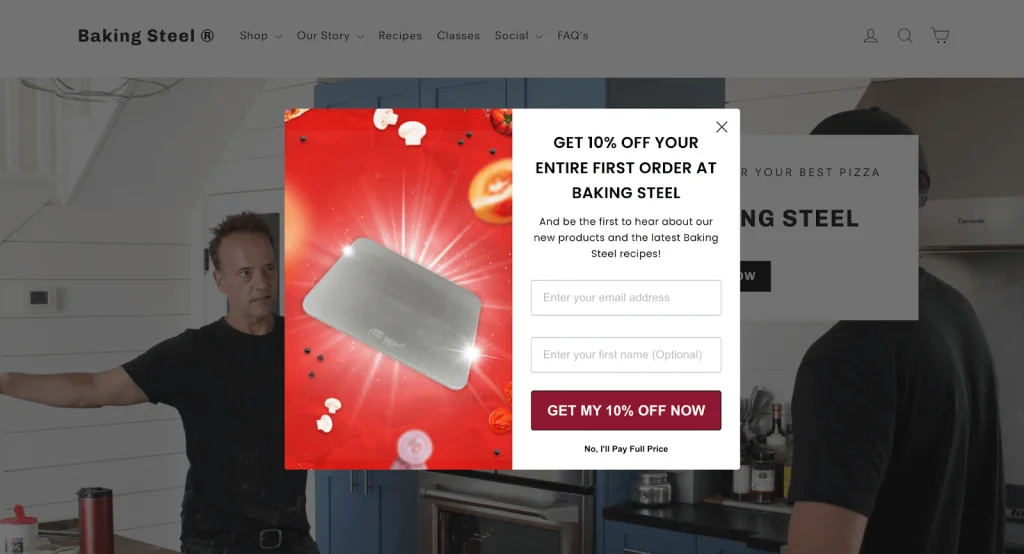
Here’s an example of a welcome email for new subscribers.

Note how it uses images to showcase the brand’s product and a detailed description of what makes it a great solution. It also shares a recipe video, providing the recipient with value right away.
This email generates $10+ on average, here’s the case study for your reference.
Want to learn by trying it yourself?
💡 Create a welcome email using a template by Omnisend
You can also watch this two-min video on email marketing best practices to create engaging welcome emails:
3. Nurture your leads
Stage: Consideration
Tools to use: Emails with customer reviews, user-generated content, free resources, case studies, and product demos.
At this stage, the prospect is actively considering your brand as a solution for their problem and comparing it to what your competitors are offering. Your goal here should be to show that they can trust your product or service as the ideal choice.
Share customer reviews and user-generated content to build trust. A research study shows 84% of consumers are more likely to trust reviews from other customers. And only 41% trust product reviews from brands.
Use case studies to show, rather than tell, how your product or service can impact the prospect’s business or life. Use a free trial, a freemium plan, or a free tool to give them a taste of what you have to offer.
How can you make your emails for the consideration stage effective?
Here’s how:
- Clearly mention your unique selling point. Highlight the unique features of your product or service.
- Use your content to anticipate and address objections the prospect may have.
- Show your commitment to addressing their concerns by always including customer support information in your emails.
- If appropriate, share blog posts with unbiased comparisons between your and your competitors’ products.
Have a look at this email. It includes a customer review that addresses prospects’ concerns about timely delivery.
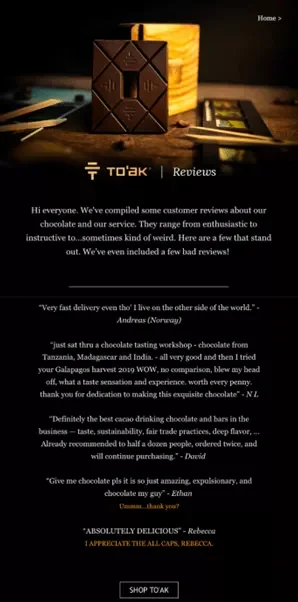
Sales funnel emails from To’ak Chocolate have led to a 460% increase in revenue from email. They ran an automated email series with Omnisend that generated 39.4% of their email revenue.
4. Convert subscribers into customers
Stage: Conversion
Tools to use: Emails with sales promotions, exclusive offers, discounts, and free shipping.
This is where you provide the recipient with a clear path to conversion. Your content should nudge them to make a purchase, sign up for a service, or whatever counts as a conversion for your brand.
Woo your subscribers with bulk offers, promotions, special discounts, and any other incentive that’ll motivate them to hit the buy button.
Here are a few tips to get great results from your email sales funnel:
- Try not to be too pushy, as this may turn your prospects away.
- Use clear and actionable CTAs. Make them easy for a prospect to follow.
- Use time-limited offers and countdown timers to create a sense of urgency.
Here’s an example. This email hints at limited stock availability, which creates a sense of urgency. The mention of free shipping also acts as an incentive.

Amundsen Sports’ promotional email campaigns account for 70.6% of its annual sales. Its order confirmation email series has a conversion rate of 31.9% and revenue-per-email (RPE) that’s 856% higher than promotional emails.
5. Build customer loyalty
Stage: Loyalty
Tools to use: Emails with useful content, emails with loyalty rewards, and exclusive benefits for customer loyalty.
Once you’ve achieved conversion from your subscriber, create email funnel marketing campaigns that’ll keep these subscribers engaged. Use these to turn them into loyal brand advocates.
Create content that educates them on how to solve their biggest problems and get the most out of your products.
You should also include interactive content like polls, contests, and quizzes that encourage active participation. It’ll create a sense of involvement to foster loyalty.
Make them feel recognized and appreciated for their loyalty using exclusive rewards or discounts and loyalty points.
Here are a few tips you can apply in your email marketing funnel:
- Building loyalty and nurturing relationships is an ongoing process. Consistently provide value to achieve that.
- Be proactive with customer support. Ensure your support team is responsive to the issues subscribers raise.
- Use an email marketing software solution that lets you hyper-personalize your sales funnel emails. You can personalize subject lines, email content, and other elements.
See how NOTIQ crafts a heartfelt appreciation message for the subscriber’s loyalty and offers a $20 reward. It makes the recipient feel valued.
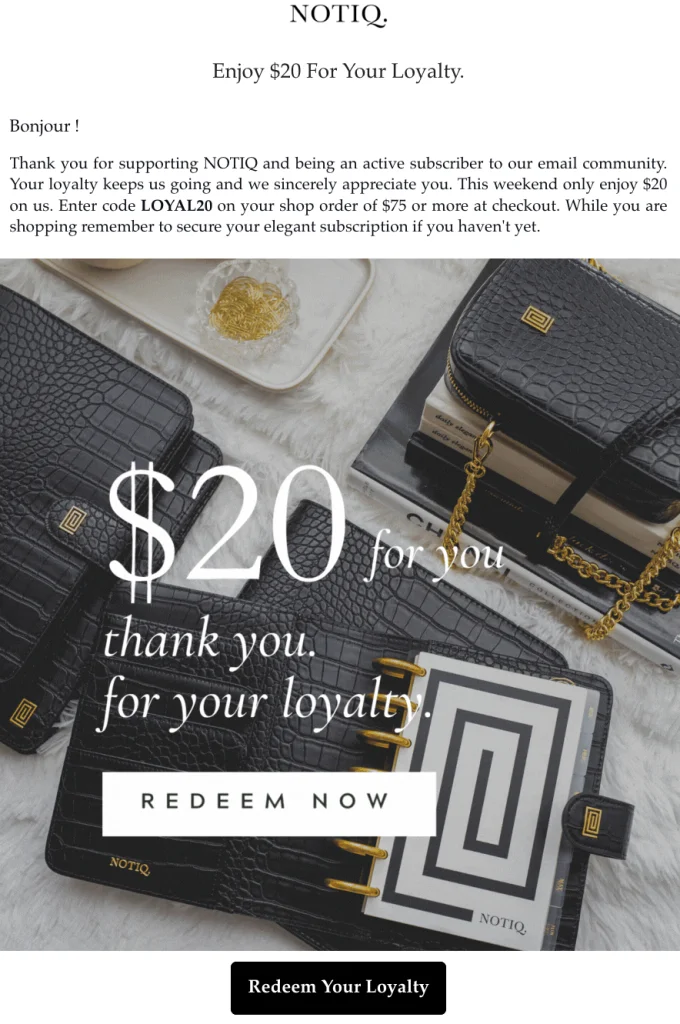
Island Olive Oil combined email automation with lifecycle stages which led to a 2,710% increase in revenue per email for “at-risk” lifecycle campaigns. Although email automation accounted for only 1.22% of its email sends, it generated 39% of their email marketing revenue.
6. Retain and re-engage subscribers
Stage: Retention
Tools to use: Emails with personalized deals, extra discounts, gifts, and other limited-time offers.
Your goal here is to keep subscribers interested. Work on optimizing your lifetime customer value and getting the highest ROI on your email funnel marketing investment.
Continually improve your customers’ experience. Provide personalized deals and discounts to cross-sell and upsell.
Here are a few tips you can apply to your email marketing sales funnel:
- Segment your subscribers: Leverage data like purchase history for email segmentation to provide personalized product recommendations
- Ensure that the sales funnel emails are relevant: Show that you understand their needs, interests, and preferences.
- Get feedback with survey emails: They’ll encourage your subscribers to engage with your brand. It’ll also help you understand their preferences and needs better.
- Clean your email list to remove fakes and duplicates: Use email list cleaning best practices to ensure you’re not wasting your re-engagement efforts on invalid email addresses.
- Send re-engagement (win-back) emails to passive subscribers: A re-engagement email marketing campaign can salvage disengaged subscribers and regain their interest. Remove the non-responders from your list.
Here’s an example of a re-engagement email. It seeks to rebuild the subscriber’s interest with a time-sensitive offer to inspire action.

Email marketing funnel: Summary
You now know what an email funnel is — a series of emails designed to nurture leads and existing customers toward conversion and loyalty, respectively.
You understand its powerful potential to build strong customer relationships and facilitate customer retention leading to a higher ROI from your funnel email marketing.
Use the tips and tools mentioned in this post to do this right.
You can get these tools from Omnisend. And you get extra features like gamification of your signup forms and the ability to add products directly from your ecommerce store to your emails. Sign up today to get access to these tools at no cost.
Source from Omnisend
Disclaimer: The information set forth above is provided by Omnisend independently of Alibaba.com. Alibaba.com makes no representation and warranties as to the quality and reliability of the seller and products.
